By Heather Ripley If you’re like most home service business owners, you understand the need for a strong marketing budget. Getting your company’s name and services out in front of potential customers is a necessity if you want to grow and scale your business. But if you’ve never considered how adding a powerful public relations Read more
Industry Blogs

By Heather Ripley
If you’re like most home service business owners, you understand the need for a strong marketing budget. Getting your company’s name and services out in front of potential customers is a necessity if you want to grow and scale your business.
But if you’ve never considered how adding a powerful public relations plan to your budget would sharpen your marketing message, 2024 might be the time to consider it.
Solidify Your Brand
While advertising your services helps get your name out to your target audience, nothing solidifies your brand in their eyes like a steady and consistent message. Whether you’re telling your company’s story or simply creating campaigns that boost your reputation, PR helps you refine your presence.
Public relations, simply put, is the art of building relationships so that you can tell your story to the people you want to hear it. A marketing campaign is great for telling others about yourself, but it takes a PR campaign to get others to talk about you.
For example, you may be running a special on furnace installations for the winter months, and you’ve purchased several ads that promote this special. People might be attracted to your company because of the special but they’re more likely to hire you based upon your brand reputation.
If you want people to trust your team with their HVAC needs, you need an expert PR team who can pitch your expertise out to your local media. Imagine how much consumer interest you’ll obtain if you’re seen on the local news talking about the energy efficiency of new furnaces.
Maintain a Positive Reputation
If you’ve worked in business for any length of time, you know that a crisis could happen at any time. It’s really a matter of “when” instead of “if” one occurs.
And it’s during these business crises that many home service companies hire a public relations professional. Having an expert in communications is often the best move if you’re trying to regain public trust.
But it’s even more appropriate to hire a PR team or have a communications strategy before you have a crisis.
Ongoing PR can help you build a relationship of trust within your community. Whether you’re asked to share tips on how to keep your pipes from freezing during a cold snap or you are working locally to support a worthy cause, associating your home service business brand with good news builds a positive reputation.
If you’re already seen in a good light, it is easier for the public to forgive any transgressions. This makes your job much easier when a business crisis occurs.
In-House or Agency
No one knows your business like you do. That’s just a fact.
But, just because you know your team, your business budget and the way to get your customer service representatives to charm the customer doesn’t mean you understand PR.
Public relations is about building relationships and it’s a multi-faceted task. It requires media outreach, well-written press releases that have a news angle and a flair for reputation management.
That doesn’t mean you can’t do it yourself. If you already have some established relationships within your local media or within the trade publications that cover your market, you can always pitch yourself. Just be sure that any communications you send to the media use proper grammar and, preferably, are written following Associated Press style.
No matter if you decide to handle your own PR or if you decide to hire a public relations agency, the fact remains that PR should be a part of your marketing budget.
Incorporating PR into your existing marketing strategy should never be considered an expense. Good PR is as much an investment into your company as purchasing new equipment or hiring trained technicians is.
So, if you’re looking to grow your home service business to reach the next level in 2024, make sure there is a healthy line item in your business budget for PR.
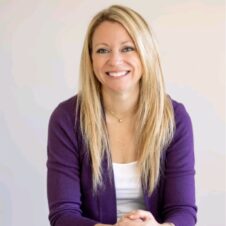 Heather Ripley is founder and CEO of Ripley PR, an elite, global public relations agency specializing in the skilled trades, franchising and B2B tech industries. Ripley PR is recognized as the top PR agency for the home service industry. It also has been listed by Entrepreneur Magazine as a Top Franchise PR Agency six consecutive years and was named to Forbes’ America’s Best PR Agencies for 2021. Ripley is the author of “NEXT LEVEL NOW: PR Secrets to Drive Explosive Growth for your Home Service Business,” which is now available on all audiobook platforms. For additional information, visit www.ripleypr.com.
Heather Ripley is founder and CEO of Ripley PR, an elite, global public relations agency specializing in the skilled trades, franchising and B2B tech industries. Ripley PR is recognized as the top PR agency for the home service industry. It also has been listed by Entrepreneur Magazine as a Top Franchise PR Agency six consecutive years and was named to Forbes’ America’s Best PR Agencies for 2021. Ripley is the author of “NEXT LEVEL NOW: PR Secrets to Drive Explosive Growth for your Home Service Business,” which is now available on all audiobook platforms. For additional information, visit www.ripleypr.com.

HVAC control helps the Chub Cay private island resort cut energy use in half Chub Cay is a resort in the Bahamas with sustainability at the heart of its operations. The operators have worked hard to transform this private island paradise into an ecotourism destination: they installed an 8-acre solar farm, which they use to Read more
HVAC control helps the Chub Cay private island resort cut energy use in half
Chub Cay is a resort in the Bahamas with sustainability at the heart of its operations. The operators have worked hard to transform this private island paradise into an ecotourism destination: they installed an 8-acre solar farm, which they use to both harvest energy and convert saltwater to fresh for drinking and utilities. They also grow a significant amount of the fruits and vegetables consumed by both guests and staff on the island.
All of these good works aren’t just for green brownie points, however: Chub Cay is completely disconnected from any larger power grid. The operators must produce every watt of power used on the island, either from solar collection or via diesel generators. Fuel is expensive, heavy, and difficult to transport. In addition to limiting their carbon footprint, Chub Cay very much wants to achieve energy independence from fossil fuels for purely practical reasons. There’s just one problem: their high-end clientele doesn’t want to sweat.
Chub Cay needed to drastically reduce energy consumption while preserving guests’ comfort. Upgrading the HVAC control systems throughout the resort was crucial to that effort – but finding the right mix of technologies was no easy task.

Chub Cay is a resort in the Bahamas
The Challenge
Even in the early stages of Chub Cay’s sustainability efforts, it was clear that HVAC control could play a massive role in reducing the island’s reliance on diesel-generated power. By simply establishing a higher temperature set point in unoccupied zones, Chub Cay could ensure they weren’t wasting money cooling empty rooms. Automated occupancy detection can be tricky, however: motion sensors often read a room full of sleeping occupants as “empty.” Having the resort’s exclusive clientele wake up drenched in sweat because the thermostat thought they were furniture was not an acceptable outcome.
In addition, both the resort’s own sustainability requirements and HVAC efficiency regulations in the Bahamas mandate the use of highly efficient mini-split units. However, connecting these modern units, including mini-split, Inverter, and VRF units, to third-party IoT control devices such as smart thermostats or building automation systems can reduce their efficiency. Why?
It’s a little-known gotcha: IoT devices and HVAC units don’t use the same communication protocols, so they’re incapable of two-way communication on their own. If you connect a smart thermostat (or other IoT control device) directly to an Inverter/VRF unit, it will no longer be able to vary its speed and output in response to environmental conditions. It becomes a single-speed unit—and often, winds up being even less efficient than a traditional HVAC compressor.
For Chub Cay to achieve their sustainability goals, they needed a smart thermostat and occupancy sensor solution that could automate different temperature set points for occupied and unoccupied rooms without relying on motion as a trigger. They also needed a control interface between the automation system and the HVAC units. And finally, they needed a platform to allow the Chub Cay staff to centrally monitor and manage the entire system.
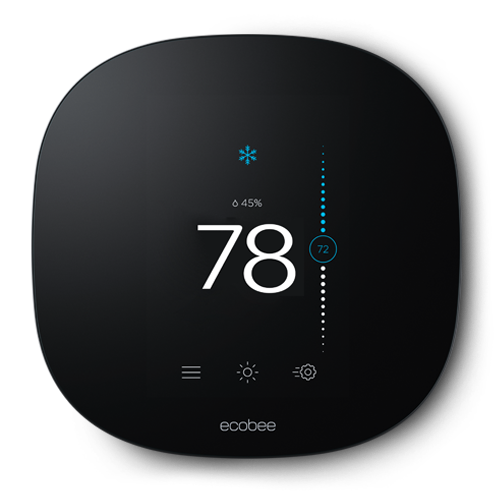
ecobee Smart Thermostat
The Solution
Richie Renaud, owner of Coconut Point Cooling and Chris Pearson, owner of Pearson AC and Refrigeration, tackled upgrading the Chub Cay Resort’s HVAC system as a joint project. They started from the challenge of occupancy detection and worked their way forward from there.
“The ecobee thermostat was the first piece of the puzzle for us,” says Pearson. “Their integrated smart sensors use Passive Infrared Radiation (PIR) to detect if someone’s in the room, not just motion detection. Even if the occupants are sleeping, ecobee is smart enough to remember that one or more of the PIR sources in the room is a human and maintain the set point accordingly.”
Through ecobee, Pearson and Renaud seemingly had a solution for two of their three design challenges. Not only does ecobee offer an occupancy-sensing thermostat with a luxury finish to match Chub Cay’s sophisticated aesthetic, but they provide the ecobee SmartBuildings app for centralized thermostat management.
However, Pearson and Renaud still needed an interface to bridge the gap between the ecobee thermostats app and the Mitsubishi mini-split units used across the resort.
“Mitsubishi does make a thermostat adapter, but we would have needed multiple shipments to source enough of them for this project,” says Pearson. “Because we had to freight all the equipment for this project to a private island, we decided to look for additional options. Our ecobee representative, Chris Vosburgh, introduced us to Airzone.”
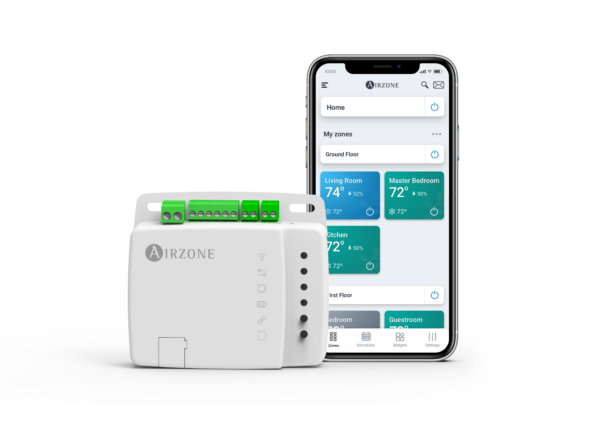
Airzone Aidoo Pro 2
Airzone has spent decades cultivating relationships with Inverter/VRF manufacturers. Their Aidoo Pro control device provides a bridge between IoT and HVAC devices by using the HVAC unit manufacturers’ own proprietary protocols to facilitate true, two-way communication. Aidoo Pro solved the control interface issue, but there was still one final missing link. This product was created for residential applications; when the project started, there was no integration between the ecobee SmartBuildings App and the Aidoo Pro.
As Pearson and Renaud installed thermostats, sensors, and control units across the island, ecobee and Airzone worked together to develop the necessary integration. Within three weeks, they developed a custom integration that allows Chub Cay’s owners to control over 40 ecobee thermostats via either the ecobee SmartBuildings app or the Airzone Cloud web interface.
The Results
When this project started, Chub Cay was already using mini-splits across the island. With these efficient units, you might expect only incremental improvements from Renaud and Pearson’s work. You’d be wrong.
“Chub Cay’s manager installed meters to monitor kilowatt usage and gauge the success of this sustainability effort,” says Pearson. “He’s seen energy usage drop by close to fifty percent.”
Where did this dramatic reduction come from? The new system puts in fail-safes for very predictable human behaviors.
“Before these upgrades, Chub Cay guests would check in and immediately crank the HVAC down to 70 degrees Fahrenheit,” says Pearson. “Staff might not notice for two to three weeks, and the resort would be burning diesel to refrigerate those rooms all the while.”
Automated set points for occupied and unoccupied spaces remove the possibility of rooms staying set to an absurdly low temperature. In addition, Pearson and Renaud trained the staff to help avoid this behavior in the first place.
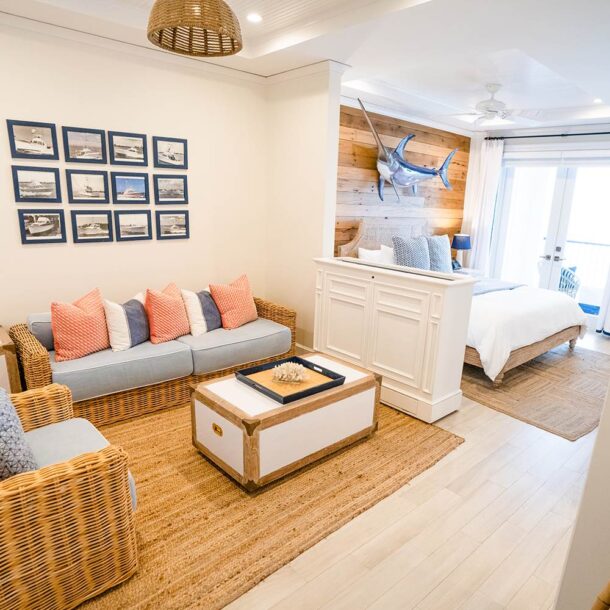
“We showed staff how to use the ecobee SmartBuildings app and Airzone Cloud to pre-cool rooms before guests arrive,” says Pearson. “That way, they’re not as tempted to put the AC on blast the moment they get there.”
This cloud-managed approach also allows Chub Cay, Renaud, and Pearson to detect and troubleshoot issues before they impact guests. A room exceeding its maximum set point can alert management to a potential HVAC issue. Using Airzone Cloud, Renaud and Pearson can even view error codes and arrive on Gekabi Chub Cay with exactly the right parts and equipment to address the problem.
Chub Cay no longer uses its diesel generators at all in the daytime, relying instead on the Bahamas’ 340 days of sunshine to power the island.
“This is an approach we could replicate all across the Caribbean,” says Pearson. “Upgrading HVAC control netted a massive energy savings for Chub Cay, and majorly simplifies operations for the island resort as well.”

By Heather Ripley Even if they don’t understand all the finer details of a marketing campaign, most plumbing company owners still understand the importance of having a marketing budget. But fewer understand the importance of also having a strategic public relations plan to help them stand out from their competition. And one of the most Read more
By Heather Ripley
Even if they don’t understand all the finer details of a marketing campaign, most plumbing company owners still understand the importance of having a marketing budget.
But fewer understand the importance of also having a strategic public relations plan to help them stand out from their competition.
And one of the most important things a company can do to boost its visibility is by repurposing its earned media.
There are three types of media: owned, paid and earned. Owned media includes things like your website or blog. Paid media includes radio or social media ads. Both of these types of marketing are firmly under your control since both involve your company’s marketing dollars.
Earned media, however, is free. It is produced by media outlets, podcasters or influencers and the content targets their audiences. It is also considered the most trustworthy type of media because it is usually produced by impartial third parties.
So, if you are quoted on how to prevent frozen pipes in a local news story or you make an appearance on an industry-related podcast, you shouldn’t limit your exposure to those outlet. Repurpose your earned media to your advantage.

Here are three ways to do that:
-
Social Media
Most studies have shown that as many as 4.9 billion people use social media. With these staggering numbers, any business not using social media to boost their visibility is missing the boat.
If you have recently made an appearance on a local news station or your company’s thought leaders were interviewed in a trade publication, you need to share that content.
Share a snippet from the article or interview and post a link so others can read or watch the entire article or appearance. You should also thank the outlet and tag them in your post.
-
Develop an Infographic
Most people are visual thinkers. That’s why articles and posts with images are far more popular and shared more often than content that has no visuals.
The information often found in the news media or trade publications often contains a wealth of solid information, but in today’s fast-paced world, many don’t have time to read all that information. That’s why you should have a graphics designer you trust on hand to develop an infographic or short video that details the information you provided to the earned media outlet.
-
Create a Blog Post
You can also repurpose the information from the article or newscast into a blog post for your website.
Not only does that get the earned media spot out to another target audience, it helps you in Google searches. Google’s algorithm is built to push websites that are constantly updated to the top of their search lists. Posting new content in the form of regular blog posts is a great way to refresh your website on a weekly basis.
Maximizing and repurposing your earned media might take a little bit of your team’s time to do well, but the rewards are worth it. Transforming the original content into a variety of formats helps spread the word about your company and your thought leadership.
By repurposing your earned media into social media posts, visuals and blog posts, you will reach a far bigger audience for much less than advertising to a smaller audience would cost.
And increased visibility helps you grow your business.
 Heather Ripley is founder and CEO of Ripley PR, an elite, global public relations agency specializing in the skilled trades, franchising and B2B tech industries. Ripley PR is recognized as the top PR agency for the home service industry. It also has been listed by Entrepreneur Magazine as a Top Franchise PR Agency six consecutive years and was named to Forbes’ America’s Best PR Agencies for 2021. Ripley is the author of “NEXT LEVEL NOW: PR Secrets to Drive Explosive Growth for your Home Service Business,” which is now available on all audiobook platforms. For additional information, visit www.ripleypr.com.
Heather Ripley is founder and CEO of Ripley PR, an elite, global public relations agency specializing in the skilled trades, franchising and B2B tech industries. Ripley PR is recognized as the top PR agency for the home service industry. It also has been listed by Entrepreneur Magazine as a Top Franchise PR Agency six consecutive years and was named to Forbes’ America’s Best PR Agencies for 2021. Ripley is the author of “NEXT LEVEL NOW: PR Secrets to Drive Explosive Growth for your Home Service Business,” which is now available on all audiobook platforms. For additional information, visit www.ripleypr.com.
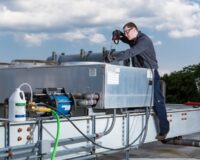
HVAC systems are crucial for maintaining the right temperature and humidity levels in plants and facilities. However, they can become problematic if not properly maintained. Goodway Technologies is sharing best practices for implementing proactive maintenance, which is essential for ensuring the effectiveness and efficiency of HVAC systems. Despite time and cost constraints, facility managers can Read more
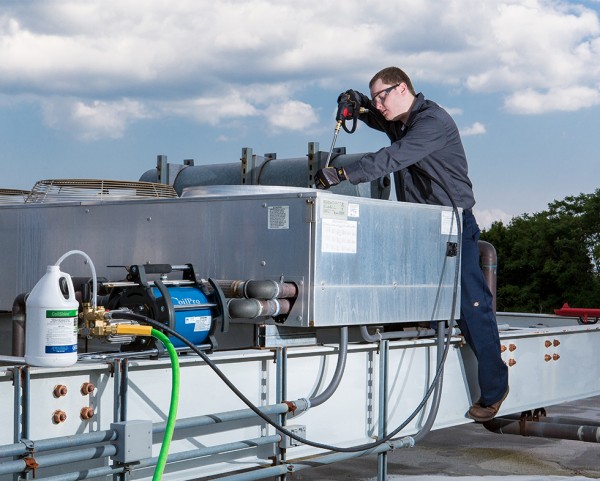 HVAC systems are crucial for maintaining the right temperature and humidity levels in plants and facilities. However, they can become problematic if not properly maintained. Goodway Technologies is sharing best practices for implementing proactive maintenance, which is essential for ensuring the effectiveness and efficiency of HVAC systems. Despite time and cost constraints, facility managers can use various tools and products to make routine maintenance quick and easy.
HVAC systems are crucial for maintaining the right temperature and humidity levels in plants and facilities. However, they can become problematic if not properly maintained. Goodway Technologies is sharing best practices for implementing proactive maintenance, which is essential for ensuring the effectiveness and efficiency of HVAC systems. Despite time and cost constraints, facility managers can use various tools and products to make routine maintenance quick and easy.
Here are five tips to help optimize a facility’s HVAC maintenance plan.
- Use the right tools for each maintenance task. Using improper tools can cause more harm than good. For example, using a pressure washer to clean coils can damage delicate fins, leading to costly repairs. Instead, invest in a coil cleaning machine designed specifically for this purpose. Some tools even incorporate clean-in-place maintenance to minimize downtime. By using the right products, it can save time, money, and prevent damage.
- Provide proper training for employees operating maintenance equipment. Include training on how to conduct HVAC maintenance and cleaning in the onboarding process for new employees. Correct usage of maintenance equipment not only saves time but also reduces the risk of accidents caused by operator error. When purchasing new equipment, consider requesting on-site training from vendors.
- Develop a maintenance plan for each HVAC system. Investing in regular HVAC maintenance can prevent costly repairs and extend the lifespan of equipment. Create a maintenance plan that includes scheduled maintenance at least once or twice a year, depending on usage. Sticking to this plan helps prevent unexpected breakdowns, outages, and repairs. Regular cleaning and maintenance also improve energy efficiency, making it a preventative measure.
- Keep an operating log. Operating logs are invaluable tools for plant maintenance. They help track the system’s operation by monitoring temperature, pressure, and fluid levels. These logs are especially useful for chillers. By regularly reviewing the log, facility managers can anticipate when maintenance or repairs may be necessary based on abnormal readings. Additionally, operating logs facilitate trend analysis, performance measurement, and year-over-year comparisons.
- Measure efficiency improvements. Measurement is often overlooked or skipped due to the time and complexity involved. However, it is important to measure the energy efficiency gains resulting from regular chiller cleaning. HVAC systems contribute significantly to operational expenses in plants. Measuring the cost savings and energy efficiency improvements achieved through maintenance work provides meaningful data for upper management.
By ensuring the facility management team is equipped with the right tools, adequately trained, maintains an operating log, and adheres to scheduled maintenance, the HVAC systems will yield positive results. For more tips, tools, and best practices in facility and plant maintenance, visit www.goodway.com.
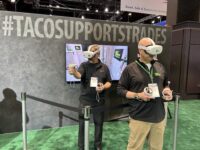
At the Taco Comfort Solutions booth at this year’s AHR Expo, the company had a new twist—a virtual reality (VR) demo and a glimpse into the future of training. Mechanical Hub caught up with Dave Holdorf, Product & Application Instructor – East for Taco. Here is what Dave had to say: With the success of Read more
At the Taco Comfort Solutions booth at this year’s AHR Expo, the company had a new twist—a virtual reality (VR) demo and a glimpse into the future of training. Mechanical Hub caught up with Dave Holdorf, Product & Application Instructor – East for Taco. Here is what Dave had to say:
With the success of the Taco training department in the residential and commercial realms, as well as our webinar series of Taco Tuesday and Taco After Dark, what could be next? We have asked customers over the years what can we do to make the training experience better? The number one answer has always been more hands on. I would then ask, “how do we do that, you mean like installing a circulator and zone valves, joining pipe and flanges and tightening bolts … you mean like work on a jobsite you were at earlier in the week?” VR gives us that ability now—building a system, repairing the seals and bearing in a split case commercial pump, things like that.
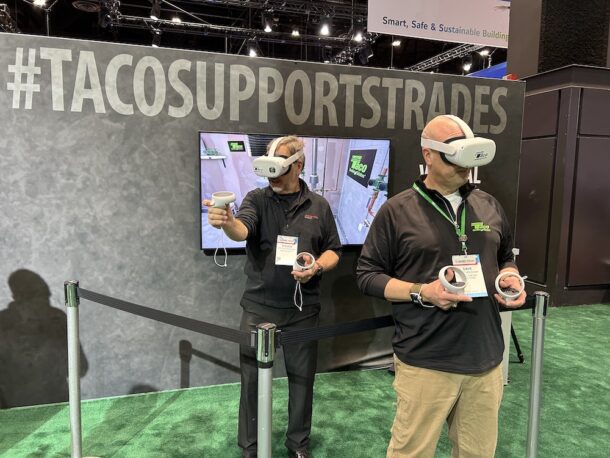
Imagine maintenance on that split case pump is coming up and you have never, ever taken one apart much less seen one in the wild, but it‘s now your responsibility to do the repair in an effective and allowable timeframe. What are the proper steps … is there a YouTube video you can watch the night before … so much pressure to get the job done right.
Now imagine a call to us and we can meet you in the “mechanical room” with that very pump in front of us. We’re standing right next to each other virtually, but you’re in Walla Walla, Washington and we‘re in Cranston, R.I. rebuilding it with you—greatly improving your confidence level, and ready for the next day. With this capability, you know the sequence, you know the names of the parts, what to look for and what not to do.
In the end, attendees of the show were surprised, but not too much. I mean, the training department has been up to so much over the last decade bringing content online and in person that it wasn’t surprising that Taco would try to increase out reach even further.
Of course, we’re just scratching the surface of where we can go with this!
